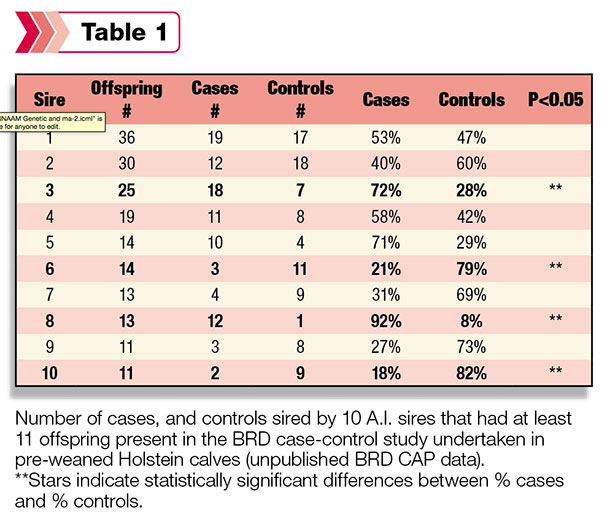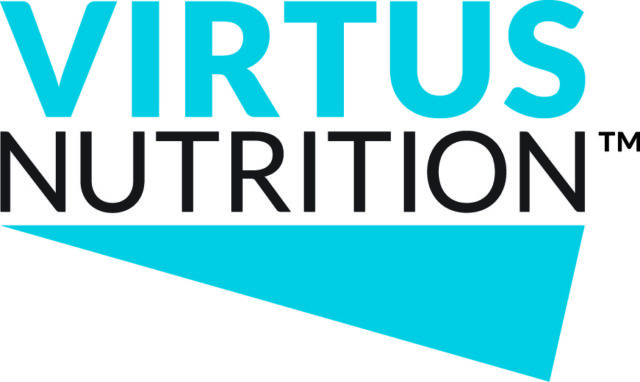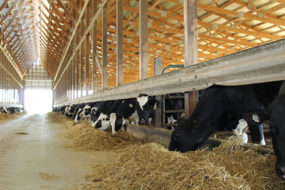Bovine respiratory disease (BRD) is commonly observed in dairy calves and has both acute and long-term effects on the performance of those calves. This disease is the most common and costly disease affecting the North American cattle industry. The key to preventing respiratory disease is to reduce stress and vaccinate animals against viruses and bacteria that cause disease.
However, there is also a growing interest in tackling this disease genetically by selectively breeding cattle less susceptible to BRD. Information on calves diagnosed with BRD is not routinely collected on most farms, nor is this trait currently included in national genetic evaluations. This precludes traditional genetic improvement; you can’t manage what you don’t measure.
With this goal in mind, a group of researchers have been working on a five-year USDA-funded project to collect a case-control dataset and use newly available genomic tools to identify host genome (i.e., DNA) regions associated with susceptibility to BRD.
The basic premise behind the project was to identify large cohorts of pre-weaned Holstein calves between the ages of 27 and 60 days housed under similar conditions. These calves were observed in the early mornings before feeding and were enrolled as BRD cases or controls based on the “Calf Respiratory Scoring Criteria” developed by Dr. Sheila McGuirk at the University of Wisconsin.
This standardized scoring system relies on assigning a severity score (0 to 3) for each of five clinical signs:
- Rectal temperature
- Cough
- Nasal discharge
- Eye discharge
- Ear tilt
A calf with a cumulative score of equal to or greater than 5 was assigned as a case, and an adjacent calf with a cumulative score of less than or equal to 3 was assigned as a control. A total of 1,382 case calves and 1,396 control calves from a large dairy calf ranch in California (2,011 calves) and from dairies in New Mexico (767 calves) were enrolled in the trial.
All calves were sampled in order to test for any BRD-associated bacterial or viral pathogens in their nasal or pharyngeal passages. The calves were also genotyped using a 700,000 single nucleotide polymorphism (SNP) panel. This information was then used to determine whether there were regions of the genome, as indicated by SNP marker associations, that are associated with BRD susceptibility.
The heritability of BRD susceptibility in this dataset, defined as the proportion of observed variation that can be attributed to inherited genetic factors in contrast to environmental ones, was found to be moderate (0.21).
This is higher than previous estimates of BRD heritability, likely due to the use of the standardized scoring system to objectively categorize cases and controls which minimized misdiagnoses (i.e., the probability that sick animals were not identified or that healthy animals were incorrectly diagnosed as ill).
The role of genetics as it relates to BRD susceptibility is simply illustrated by looking at the distribution of A.I. sires among the case-control Holstein calves enrolled in this study.
We examined sires that had 11 or more calves in the dataset to determine whether sires generated case and control calves at an equal rate or if there was a tendency for some sires to produce a disproportionately high number of either category.
It can be seen in Table 1 that some sires produced proportions of case (e.g., sire 3 and 8) and control (e.g., sire 6 and 10) calves significantly higher than expected. If sires 6 and 10 have acceptable genetic merit in other traits of economic importance, then their use could offer an approach to affect a sustained decrease in the incidence of BRD complex in dairy cattle.

The genetic analysis revealed more than 100 genomic regions that were significantly associated with BRD in both the New Mexico and California populations, many of which were associated with biologically meaningful genes.
Future work includes refinement and validation of the diagnostic marker set and implementation of BRD susceptibility prediction into national cattle genetic evaluation schemes. In the case of Holstein dairy cattle, this will be done within the context of other traits of economic importance in the dairy Net Merit Index ($NM).
The importanceof recording health traits
For BRD to become routinely included in dairy cattle genetic evaluations, standardized BRD health event data will need to be recorded on-farm and fed into the national genetic evaluation system. Several studies show the use of direct health observations is an effective way to incorporate heath traits into breeding programs.
Such observations require a standardized system to record diagnoses to ensure phenotypes are comparable between farms. To be successful, there needs to be a balance between the effort required to collect these data and subsequent benefits.
With this goal in mind, data from the large BRD case-control study described previously was used to develop a simplified BRD scoring system for pre-weaned calves. The rationale behind this development was the need to determine the BRD health status of calves on extensive calf-raising facilities where hundreds, if not thousands, of calves may be evaluated daily.
This simplified scoring system, which requires a simple normal or abnormal categorization of clinical signs and involves temperature collection in only a subset of suspect calves, was independently validated and is available in both English and Spanish.
The hope is that this simplified standardized scoring system will be used by dairy producers and calf raisers to diagnose and treat BRD and will help to facilitate the routine collection and recording of standardized BRD health event data on-farm.
Summary
- Bovine respiratory disease (BRD) is a significant cause of morbidity, mortality and economic loss, and is an animal welfare concern.
- Economic costs associated with BRD include treatment expense, mortality, premature culling, reduced growth, impaired fertility and reduced milk production in adulthood.
- Large BRD case-control pre-weaned Holstein calf populations have been assembled to enable the development of genomic breeding values for BRD susceptibility.
- Preliminary data shows BRD susceptibility has moderate heritability, suggesting that there is an opportunity for improved animal health through selection.
- In the long term, incorporation of BRD as a health trait into genetic evaluation programs will require a system to record standardized BRD diagnoses on farm to enable the development of a large dataset of producer-recorded health data.
- Selection for animals with less susceptibility to BRD offers a promising long-term and permanent approach to decrease the incidence of this most common infectious disease and leading natural cause of death among cattle in the U.S. PD
The research described in this article was conducted by the Bovine Respiratory Disease Consortium Coordinated Agricultural Project (BRD CAP) team members with funding from the USDA National Institute of Food and Agriculture (Competitive Grant no. 2011-68004-30367; J.E. Womack, PI). More information about the BRD CAP can be found online. Development of the simplified BRD scoring system was funded by the University of California – Davis, Division of Agriculture and Natural Resources (Grant no. 1753; S. S. Aly, PI), with sincere thanks to the study dairies and calf ranch owners for their participation, and Mr. Paul Rossitto, at UC – Davis Veterinary Medicine Teaching and Research Center, Tulare, California.
This article is an abridged version of a paper presented at the Western Dairy Herd Management Conference, held March 3-5, 2015, in Reno, Nevada.
-
Alison Van Eenennaam
- Cooperative Extension Specialist Animal Genomics and Biotechnology
- University of California – Davis
- Email Alison Van Eenennaam






